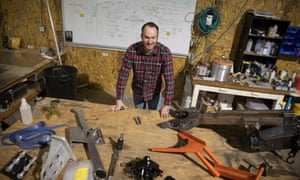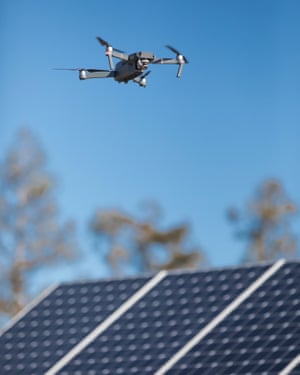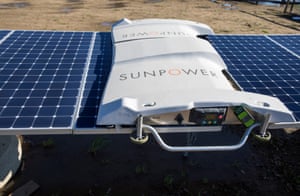Source: theguardian.com
Published: February 26, 2017

Kingsley Chen, the drone fleet coordinator at SunPower, demonstrates the use of a drone to survey land for designing a solar power plant. Photograph: Robert Durrell/The Guardian
A cottage industry is growing around new technology for solar power developers to design, build and operate solar farms to help compete with fossil fuel power
At the edge of a plot of muddy farmland, a few miles down the road from the University of California at Davis, an engineer takes a few quick steps across crop rows and lets go of a three-foot drone. Within seconds, the device – which weighs less than 2lbs and carries a powerful camera – ascends hundreds of feet into the cold, clear, blue sky and begins to snap detailed photos of the ground far below, including a long row of large solar panels mounted on steel poles.
This flight is just a test, demonstrated by Kingsley Chen, the drone fleet coordinator for SunPower at the solar company’s research and development center, which is under construction and about a two-hour drive northeast of the San Francisco Bay Area. The drone will enable SunPower to survey a wide region and help design a solar power farm that can fit more solar panels on a piece of land, more quickly and for lower costs than it previously could.
The test highlights a growing use of the latest computing technologies – drones, robots, software, sensors and networks – by US companies to design, build and operate solar farms. After seeing the prices of solar panels drop dramatically over the past decade, companies are looking for new ways to cut costs and compete with fossil fuel power through project design.
Cutting down the amount of land used by solar farms has additional benefits, particularly in places like California. It minimizes environmental impact, an issue that can be controversial for large projects built for utilities because they tend to spread across hundreds of acres of land in remote regions. Some of these projects have riled environmentalists, attracted lawsuits and forced solar companies, including SunPower, to commit money for land for wildlife conservation.
“Solar companies and service providers are using many different types of technology to optimize both the deployment of solar and the operations and maintenance of solar,” says Justin Baca, the vice president of markets and research for the solar group Solar Energy Industries Association. He adds: “It’s all about cutting costs.”
An increase in tech investment could help to boost growth as more large solar and wind farms come online in the US and worldwide over the next few decades. The US Energy Information Administration predicts that more solar power plants will be built and provide 1.4% of the country’s electricity by 2018, up from less than 1% in 2016. While solar makes up a tiny portion, it’s among the fastest-growing sources of new electricity generation capacity in the country.
 Marc Grossman, principal design engineer at SunPower, at his work station at the company’s R&D center in Davis, California. Photograph: Robert Durrell/The Guardian
Marc Grossman, principal design engineer at SunPower, at his work station at the company’s R&D center in Davis, California. Photograph: Robert Durrell/The Guardian
Solar Tetris
“It’s like a big Tetris puzzle,” says Matt Campbell, vice president of power plant products at SunPower, as he and his team show off the company’s solar farm design software.
On a screen is a detailed image of land that one of SunPower’s 10 survey drones has collected from the sky. Overlaid on the photos are Tetris-looking colored blocks that represent solar panels and inverters, which convert the direct current produced by the panels into electricity for the grid. A SunPower engineer can use the software to fit as many of the blocks as possible while laying out the configuration of a power plant.
The company designed its algorithms to take into account hundreds of factors that a human engineer might overlook, such as where transmission lines will be or how much shade will be created by the panels as they follow the sun throughout the day.
A decade ago, a survey of a project site would require dispatching a crew to gather information such as the steepness of a slope and the vegetation of the region, explains SunPower’s CEO and president Tom Werner. In contrast, using the software and drones enables engineers to design a project 90% faster, he adds.
 A solar power plant owner would dispatch this type of drone to take infrared images of solar panels to ensure they are working properly. Photograph: Robert Durrell/The Guardian
A solar power plant owner would dispatch this type of drone to take infrared images of solar panels to ensure they are working properly. Photograph: Robert Durrell/The Guardian
SunPower, a solar panel maker and solar farm developer in the US, is creating most of the technology it uses for project design. Meanwhile, a cottage industry is growing around creating technology for other solar power developers to design, build and operate solar farms.
One of these is HST Solar, a four-and-a-half-year-old startup in Los Angeles that, like SunPower, has developed algorithms to swiftly plot out the best designs, layout and wiring for large solar farms. Using HST Solar’s artificial intelligence software, launched last year, companies can lower the costs of producing solar electricity by 30%, says Santanov Chaudhuri, co-founder of the company.
So far, Chaudhuri says that customers have used the company’s software to design about 4 gigawatts of solar projects, which is about the amount of solar panel projects that are installed across the US in a single quarter.
It isn’t just the sprawling solar farms that are benefiting from software and design tools. An Oakland, California, startup called PVComplete builds software for designing solar panel projects on rooftops. The software enables any engineer to design a system using a range of solar equipment, while also taking into consideration different local requirements, such as weather, for installing them.
Claudia Eyzaquirre, who has worked in the renewable energy business for a decade, co-founded PVComplete in 2015 after noticing that all of the major solar companies were spending big money to build their own design software. But few options were available to smaller solar companies that didn’t have the money to do the same.
SunPower uses robots to clean solar panels in order to cut water use and lower the labor cost. Photograph: Robert Durrell/The Guardian
Solar companies are also turning to the latest in computing technology to operate and maintain solar farms, not just design them. In 2013, SunPower bought a startup called Greenbotics, which developed a robot that lowers the cost of cleaning solar panels while using less water than human washers can do. The Greenbotics team now works on engineering projects at SunPower and manages SunPower’s fleet of 40 solar-panel cleaning robots.
Solar developer Strata Solar uses drones with infrared cameras to survey the more than 1 gigawatt of solar projects after they’re operating. The images from the cameras can reveal any solar panels that aren’t producing electricity.
“It’s a great way to check on the overall health of the systems,” says Gabe Cantor, Strata Solar’s director of design engineering. “You can spot problems down to the cell level.”
Drones – who needs them?
While drones are playing an increasing role in the solar industry, many companies aren’t convinced that they are cost effective, notes a report by The Electric Power Research Institute, which conducts research for the power industry.
The technology being used by some in the solar industry isn’t as “sexy” as drones, says Jenny Chase, head of the solar research at Bloomberg New Energy Finance. A lot of it is “boring tech – like software”.
First Solar, one of the largest power plant developers in the country, has experimented with drones for designing power plants and thermal imaging of operating solar farms. But it isn’t rolling them out for company-wide use right now.
First Solar’s manager of business development, Jeremy Rand, says drones and robots aren’t sophisticated enough or affordable: “A lot of these technologies are in the experimentation phase and not quite there yet.”
The falling prices for solar panels also make it difficult to justify an investment in emerging and more expensive technology, Rand adds. Both First Solar, and fellow manufacturer SunPower, saw their stock prices fall last year and now plan to cut thousands of jobs.
“With the solar module price collapse, it’s a tough time to be truly inventive,” Rand says.
But overall, the solar industry is investing in better technology because it has a long way to go to replace fossil fuels. The US solar energy industry is also facing an elimination of the tax subsidies that have historically been important for growth. At the same time, President Trump hasn’t made it clear on his policy for solar energy.
“Technologies like (ours) can ultimately make solar independent without tax credits, and without subsidies, and much sooner than people think,” HST Solar’s Chaudhuri says.

